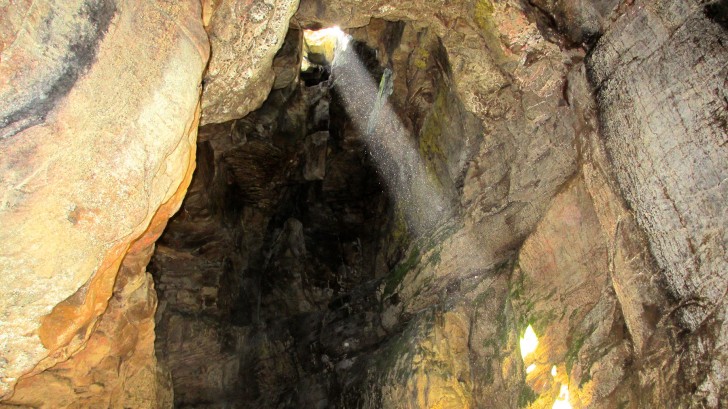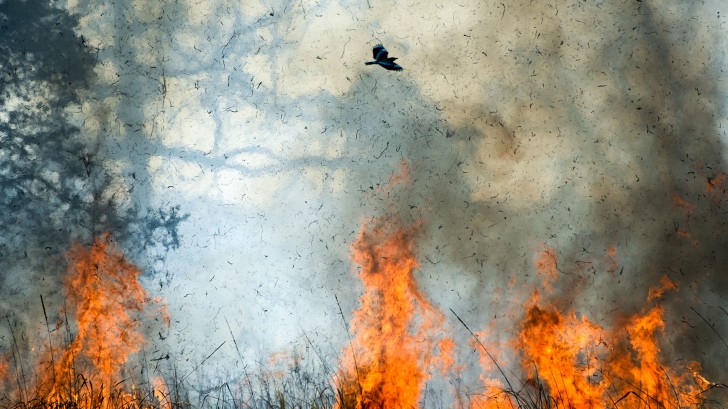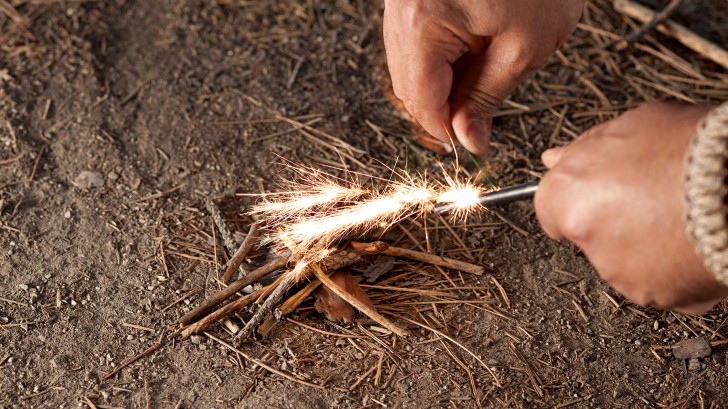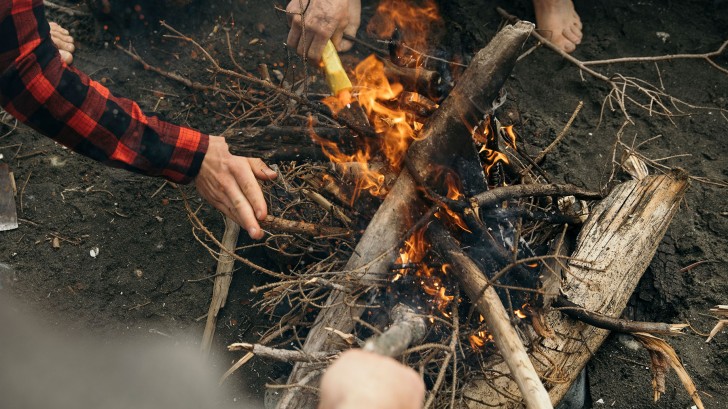If you found yourself empty handed in a forest, out on the savannah, or up on a mountain, would you be able to start a fire just with the rocks, soil and wood around you?
How would you do it? Would you rub two sticks together like you’ve seen in the movies? Or play around with smashing different kinds of stones together until the right combination threw off sparks? How long might you try until you gave up if it didn’t work?
And perhaps most importantly: why would you do it? To keep yourself warm? Cook food? Keep dangerous animals away?
“Fire is fundamental to the human condition – everybody today uses fire, we just don’t see it as often because we hide away in factories and internal combustion engines, but everything we have around us is based on fire at the most basic level,” says archaeologist Andrew Sorensen of the University of Leiden.
Yet are we the only hominins (humans) capably of creating and harnessing this powerful force? The myriad questions surrounding when, why, where, and how our ancestors first made fire are intellectually tantalizing yet infuriatingly difficult to answer.
“We know fire plays a gigantic role in human evolution, but we just don’t have any clear smoking guns that tell us when humans figured out how to start a fire at will – it’s just not clear,” says Francesco Berna of Simon Fraser University in Canada who excavates Early Stone Age sites in South Africa and Israel.
It all starts in a cave
In 2012, Dr Berna reported in the journal PNAS that his team had unearthed traces of burnt bones and ashed plant remains in the Wonderwerk Cave in South Africa, which they estimated to be a million years old. At the time, they believed these were the earliest “unambiguous evidence” for hominins controlling fires. The culprit would have been one of the progenitors of our species, either Homo ergaster or Homo erectus. But now he says he has found traces of fire that are even older from the same cave, which they date to between 1.6 and two million years ago – their results will be published in the coming year.

But being able to use fire is not the same thing as being able to make fire.
Using fire vs making fire
Dry weather and lightning spark natural fires routinely – one only has to look at the forest fires in California last year, or the blazes on England’s moors this summer to see how easily they can spread for days, even weeks.
Archaeologists reason that long before any of our ancestors or relatives figured out how to make fire from scratch they would have captured flames from wildfires using branches or another woody fuel. Even birds are known to do this. For example, just this year Australian scientists observed raptors plucking flaming twigs and dropping them further afield to flush out prey.
Early hominins would have taken things to the next level by capturing flames from a wildfire, bringing them to a contained hearth, and keeping a fire going by continually adding fuel. Our ancient ancestors Homo habilis, and possibly Australopithecus, would have maintained fires in this way at the two-million-year-old site Berna investigates, he says.

Most of the oldest sites in Europe that indicate regular fire use range between 300,000 and 400,000 years old, though a handful of sites are even older, notably Qesem in Israel, approximately 780,000 years old, and Cueva Negra in Spain, 800,000 years old. But these only indicate fire use – not fire creation.
So just when did we make the leap from simply capturing and maintaining fire to creating it from scratch?
Does the ability to make fire define our species?
This is where the debate becomes more complex, confusing – and controversial. Scientists aren’t just keen to understand the when, where, how and why – they also want to know whocould make fire.
The standard thinking goes that only Homo sapiens knew how to create fire. If this is true, it would make fire creation one of the things that define our species.
Biologists have long sought to understand what it means to be human by identifying what traits could be unique to us – such as language, theory of mind, or concept of time.

But time and time again zoologists have found evidence of supposedly “human” traits in other animals, including dolphins, chimpanzees, birds and even cephalopods.
Could the ability to make fire be uniquely human? It has been argued that our species is an “obligate” fire user – all civilisations depend on it in some form for heat, food, and light. Our relationship with fire is even written into our genes: in 2016 researchers identified a genetic innovation, the “AHR” gene, that protects us against the carcinogenic effects of wood smoke. This genetic innovation seems to have made our cells 1000 times more resilient to the carcinogenicity of the polycyclic aromatic hydrocarbons. Neanderthals did not possess this gene.
Neanderthals used fire, but could they create it?
Our cousins, it would seem, could use fire, but not make it on a constant basis. “At some Neanderthal sites you find hearths that have absolutely enormous amounts of ashes, which implies they had to keep a fire going constantly because they didn’t know how to start it again if it went out,” says Berna.
Professor Dennis Sandgathe, also of Simon Fraser University, agrees. “Neanderthals clearly used fire – there is no question about that,” he says. “But we’re saying that they didn’t need fire.”
Sandgathe says that the shorter, stockier Neanderthals would have been better adapted to cold climates than Homo sapiens. Their bulkier bodies would have lost less heat, meaning Neanderthals could have coped more easily than us with glacial periods in modern-day Europe.
When wildfires spread due to hot weather and lightning storms, Neanderthals would have captured their flames and used them for cooking and crafting tools. In 2006, Italian scientists reported in the Journal of Archaeological Science evidence from the Campitello Quarry just south of Florence that Neanderthals used fire to create birch bark pitch to adhere flint shards to wooden handles. This year, another group of Italian archaeologists reported in the journal PNASdiscovering elsewhere in Tuscany what they believe to be the oldest multipurpose tool ever found: 170,000-year-old wooden “digging” sticks created by Neanderthals who used fire to more easily strip bark off branches.
Though they clearly used fire, Prof Sandgathe argues Neanderthals were incapable of making fire on their own. His excavations of Neanderthal sites at the Roc de Marsal in France, described in the journal PaeloAnthropology in 2011, reveal more traces of fire from interglacial periods than glacial ones.
Why would Neanderthals use fire less during cold periods? Because there are more thunderstorms and more dry vegetation to spark wildfires during warmer periods. If Neanderthals could make fire, they would have done so to a greater degree during cold times, leaving more traces of fire in the fossil record during glacial periods. But we do not, says Prof Sandgathe, therefore Neanderthals could not make fire at will.
“We are at pains to stress this: we are not suggesting that if Neanderthals couldn’t make fire that means they were cognitively inferior – not at all,” he says. “There is nothing obvious about the fact that rubbing sticks or smashing rocks will create sparks or flames. Making fire is something you have to learn. It’s not an indication of cognitive ability.”
More recently, in a number of papers published in 2017 in the journal Current Anthropology, Sandathe reviewed all the evidence to date and in particular the presentations at a 2015 symposium on fire use by hominins, and he maintains that the most likely answer is still that Neanderthals could not make fire.
“We do not think that Neanderthals were dumb, and we get very peeved with colleagues who think that is what we are saying,” he says. “They weren’t dumb – just different.”
There is ample evidence that Neanderthals were hardly the brutish, dim-witted ogres we once believed them to be. More recent discoveries have indicated they ritually buried their dead, carried medicines such as aspirin and penicillin, wore manganese dioxide body paint, had larger brains than us, and created cave paintings long before humans had even arrived in Europe.
Still, argues Sandgathe, they could not make fire from scratch. And it was the mastery of fire by humans that allowed them to colonise Europe and eventually out-compete them.
“Neanderthals were anatomically adapted to cold climates – but they never fully managed to reach northern latitudes like humans managed to,” agrees Berna. “They basically disappear at the peak of the last glaciation, when modern humans came in and thrived. This could have been because we alone controlled fire.”
But not everyone agrees
Dutch archaeologist Professor Wil Roebroeks of the University of Leiden says evidence suggests European Neanderthals could not only create fire, but were just as adept as us at using it. He says the evidence suggests Neanderthals were creating birch bark pitch using fire tens of thousands of years before humans at Pinnacle Point in South Africa used it to fashion tools.
After finding unusually large numbers of chunks of manganese dioxide at the Pech-de-l’Azé site in France, in 2016 Prof Roebroeks proposed in Nature Scientific Reports that Neanderthals would have used the black mineral not for body decoration or art, traditionally imagined uses for the material, but for creating fires.
Manganese dioxide – commonly used today in fireworks – lowers the ignition temperature of wood from 350C to 250C, meaning that sprinkling a bit of the mineral onto a pile of tinder makes it easier to start a fire. If they were indeed creating fires in this way, it pushes the date of fire creation by Neanderthals to 200,000 years ago.
It might seem slightly far-fetched to imagine that our thick-browed cousins would have this understanding of chemistry, but Andrew Sorensen of the University of Leiden agrees.
“Fire is such a useful tool, which improves so many aspects of daily life. If you can figure out any easier way to make it, you will go out of your way to maintain that method in the future,” he says.

Sorensen thinks that it’s very likely that Neanderthals would have routinely made fire by striking flint against pyrite – the so-called “strike a light” method.
Making a fire using the “wood on wood” method requires a huge amount of effort. “You will never create a fire just by drilling into a piece of wood or casually rubbing two pieces of wood together,” he says. “But inventing percussive fire making by accident when rubbing two stones together is quite easy.” His own experiments show it takes less than 100 strokes to make a fire rubbing the right combination of stones together. Moreover, sulphuric iron nodules, also called pyrite, make excellent hammerstones for the “strike a light” method of fire creation and they are abundant in the fossil record.
But if Neanderthals could make fire, why would you see fewer fires during glacial periods, which Prof Sandgathe says implies they could not make fire and instead were reliant on wildfires?
Last year in the journal Quaternary International, Sorensen argued that though it might seem counterintuitive, if a species can create fire, it would leave fewer traces of fire in the fossil record, not more, because it would not have to keep fires going continually and could economise fuel by using it sparingly when needed. As there would be fewer trees growing during an ice age, hominins would want to be prudent about when they used them for fuel.
This summer, Sorensen’s latest paper was published in Nature Scientific Reports. In it he describes gathering a number of handaxe tools from a 50,000-year-old Neanderthal site in France, which were covered in striations that look like they were struck repeatedly to create fire. Sorensen also performed 32 experiments with 11 different types of rocks and minerals found at sites from this era, and found that striking the rocks to create fire left marks that most closely resembled the 50,000-year-old artifacts.
The debate continues
Sandgathe remains unconvinced that Neanderthals could make fire. “I think Sorensen is too quick to throw out the idea that these striations are post depositional – they could have been left from being buried for tens of thousands of years,” says Sandgathe. “Moreover, like manganese dioxide idea, if bifaces were used regularly for starting fires by striking them against pyrite minerals then we should see two strong patterns in the archaeological record: one, an increased frequency of pyrite in the layers, and two, regular fire residues in these same layers,” he says. “We find neither. And in the Neanderthal sites we have excavated, we find almost no heated stones or bones, so it is clear that Neanderthals were regularly using these sites over thousands of years during very cold periods without the benefit of fire. There doesn’t seem to be any getting around this.”
Whether or not Neanderthals could make fire remains a contentious debate. And to complicate things, humans have been known to lose the ability to make fire – a handful of hunter-gatherer tribes worldwide have been discovered who lacked fire. It’s possible that fire was invented several times independently, and it’s even possible that humans could have shared the ability to make fire with Neanderthals – we know that we interbred with them, so we clearly would also have had enough contact to share fire-making techniques with them.

And to even further complicate matters, Professor Richard Wrangham of Harvard thinks we would have been using fire routinely not just 50,000 or 400,000 years ago, but two million years ago. In his book Catching Fire: How Cooking Made Us Human, he argues that it was the act of cooking that transformed our ancestors from ape-like creatures into the large-brained Homo erectus, for the simple reason that cooking makes it easier to extract energy and nutrition from our meals. Ultimately allowing our ancestors to evolve larger brains in concordance with smaller guts.
“From my point of view what is puzzling about the whole debate about who first made fire and when, is that it is clear that Neanderthals in general were using fire a lot, so I can’t imagine that once they were using it they would ever have been able to survive without it,” says Prof Wrangham. “I just can’t escape the logic that says the morphology of humans and our ancestors means that they must have been cooking food two million years ago. I will be stuck in that idea until someone can find a reasonable diet, other than cooked food, to explain how Homo erectus digested their food with their relatively small teeth and small guts.”
Whatever the answer is, the questions swirling around how our ancestors discovered how to make fire will not disappear anytime soon.
“I love studying the puzzle of when we first made fire because it’s just so mysterious,” says Berna. “I really think that once we have solved this puzzle, we will have grown so much in our understanding of what it means to be human.”